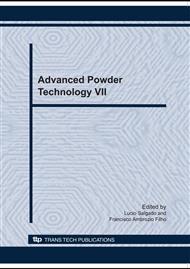[1]
L.L. Hench and J. Wilson: An Introduction to Bioceramic (World Scientific, Singapore (1993).
Google Scholar
[2]
D.F. Williams: Medical and Dental Materials (VCH Weinheim, New York 1992).
Google Scholar
[3]
L.L. Hench: J Am Ceram Soc; v. 81, n. 7 (1998), pp.1705-28.
Google Scholar
[4]
A.S. Kumar, A.R. Durai and T. Sornakumar: Materials Letters, v. 58 (2004), pp.1808-1810.
Google Scholar
[5]
A.H. Heuer, C.R. Haim and V. Lanteri, in: Advances in Ceramics. v. 24 - Science and Technology of Zirconia III, edited by Trans Tech Publications Switzerland (1988), pp.3-20.
Google Scholar
[6]
M.C.A. Nono: Cerâmicas à base de zircônia tetragonal policristalina do sistema CeO2-ZrO2 (Ce-TZP), S.J. Campos-SP, ITA-CTA, 1990, Doctorate Thesis.
Google Scholar
[7]
R. Stevens: An Introduction to Zirconia, 2nd ed. (Twickenham, New York 1986).
Google Scholar
[8]
B. Basu, J. Vleugels and O. Van Der Biest, J. Materials Research, v. 16, n. 7 (2001), pp.2158-2169.
Google Scholar
[9]
B. Basu, J. Vleugels and O. Van Der Biest, Key Eng Mater, v. 206-213 (2002), pp.1185-1188.
DOI: 10.4028/www.scientific.net/kem.206-213.1185
Google Scholar
[10]
B. Basu, J. Vleugels and O. Van Der Biest: J Alloys and Compounds, v. 372, n. 1-2 (2004), pp.278-284.
DOI: 10.1016/j.jallcom.2003.09.157
Google Scholar
[11]
K. J. Anusavice: Phillips' Science of Dental Materials, 11th Edition (Elsevier, UK 2003).
Google Scholar
[12]
P. Zhu, Z. Lin, G. Chen and I. Kiyohiko: Int J Fatigue, v. 26 (2004), pp.1109-14.
Google Scholar
[13]
M.J. Mayo: Int. Mater. Rev., v. 41 (1996), p.85.
Google Scholar
[14]
ASTM: C1327-99: Standard test method for Vickers indentation hardness of advanced ceramics, pp.1-8, (1999).
Google Scholar
[15]
ASTM: C-1421-99: Standard test method for determination of fracture toughness of advanced ceramics at ambient temperature, pp.1-32, (1999).
Google Scholar
[16]
G.R. Anstis, P. Chantikul, B.R. Lawn and D.B. Marshall: J. Amer. Ceram. Soc. v. 64, n. 9 (1981), pp.533-538.
Google Scholar
[17]
M.R. German: Powder Metalurgy Science, 2. ed. (Ed. Metal Powder Industries Federation, Princeton 1994).
Google Scholar
[18]
D. W. Richerson: Modern Ceramic Engineering (Marcel Dekker, Inc., New York 1982).
Google Scholar
[19]
J.S. Reed, Introduction to the Principles of Ceramic Processing (John Wiley & Sons, New York 1988).
Google Scholar
[20]
M. W. Barsoum: Fundamentals of Ceramics. (McGraw Hill, New York 1997 ).
Google Scholar
[21]
N. J. Shaw: Powder Metallurgy International, v. 21, n. 3 (1989), pp.16-29.
Google Scholar


